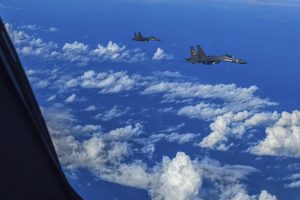Todd Hall

China’s People’s Liberation Army (PLA) announced on August 10 that its joint military operations around Taiwan are now completed. This appears to mark a close to a significant display of force in the waters around the island that eclipsed — in terms of both proximity to Taiwan and the number of ballistic missiles fired — the measures Beijing took during the last Taiwan Strait Crisis in 1995-96. Beijing has made no secret of the fact that the exercises were a direct response to a visit by the speaker of the U.S. House of Representatives, Nancy Pelosi, to the island on August 2-3, despite China’s explicit warnings not to go.
These exercises were only one part of a larger, coordinated display of outrage (what I have elsewhere called Beijing’s “diplomacy of anger”) that has included not just saber rattling, but also rhetorical barrages, a downgrading of contacts, sanctions on various individuals, punitive economic measures, and calls for the U.S. side to correct its mistakes. There are various possible reasons for why Beijing has responded so vehemently to Pelosi’s visit, including perceptions that Washington is seeking to hollow out previous commitments, concerns about external reputation and domestic politics, or even Chinese leader Xi Jinping’s own views.
Regardless, the situation in Taiwan Strait has become more tense in the past week than it has been in decades. It still remains to be seen what further measures may be forthcoming; the PLA has stated that it will “continue to carry out military training for war preparedness, and organize normalized combat-readiness security patrol in the Taiwan Strait to defend China’s sovereignty and territorial integrity.”
As developments in the Taiwan Strait were unfolding over the past week, various commentators repeatedly warned about the risk of miscalculation or accident. An errant missile, a collision on the sea or in the air, a feigned attack that elicits an all-to-real reaction – all were conceivable scenarios that could have led to immediate loss of life and escalation in their aftermath. Fortunately, none of those occurred. That said, a scenario just as plausible – but that has received less attention – is one in which events spiraled into violence not because of a mistake or miscalculation, but because the participants perceived no other choice.
To elaborate, for both Beijing and Washington, the issue of Taiwan is one that can quickly implicate larger stakes.
For China, letting perceived provocations by the United States go unanswered would belie its claims to now be in a position of much greater strength than in the past, reveal that actors can defy it without significant consequence, and raise questions about the substance behind its bluster, both domestically and abroad. Very likely, these considerations were already informing Beijing’s calculations when it chose how to respond to Pelosi’s visit last week. But hypothetically speaking, it is very likely that had Washington then countered with a major deployment of military assets around Taiwan, that would have even further stoked Beijing’s concerns. Such a move would have been reminiscent of Washington’s behavior during the Third Taiwan Strait Crisis (1995-96), when it dispatched two aircraft carriers to the waters near Taiwan – an action that at the time confronted Beijing with U.S. military superiority and its own relative weakness. This time around, Beijing might have felt compelled to take more forceful countermeasures in order to demonstrate that it would no longer allow others to push it around, that the China of today is not so easily cowed or humiliated, especially when its perceived core interests are at stake.
For Washington, how it responds to developments involving Taiwan also implicates potentially larger stakes: the perceived strength of its commitments in the region, its willingness to defend its right to “fly, to sail and to operate wherever international law allows,” or the possibility it would look weak should it leave unchallenged perceived attempts by Beijing to alter the status quo.
Indeed, in the Third Taiwan Strait Crisis over 25 years ago it was reputational issues that motivated Washington to send aircraft carriers. As Robert Ross, a professor of political science at Boston College, noted in his excellent research article on that episode, Washington saw itself as having to react so as to demonstrate it had not “lost interest in that area of the world” or allow doubt to be cast on its “security commitments to regional allies.” Given the backdrop of a shifting balance of power – in the strait, in the region, and globally – such concerns are even more salient today.
So, in short, the danger also existed – and continues to exist – that both sides might walk open-eyed into a situation where the perception of larger (and for the most part intangible) stakes like reputation, status, and issues of principle would drive them to believe they have no option but to respond, thereby further escalating tensions and provoking each other all the more. As I have written elsewhere, such action-reaction dynamics can generate a spiral of increasingly inflated stakes that, in turn, work to propel ever more risky or confrontational behavior on the ground.
At present, the U.S. government has said that it “will not take the bait” to escalate the crisis. All the same, Washington has already suggested it will transit the Taiwan Strait in the coming weeks to uphold freedom of navigation. We can only hope that one thing does not, in this case, lead to another.
No comments:
Post a Comment